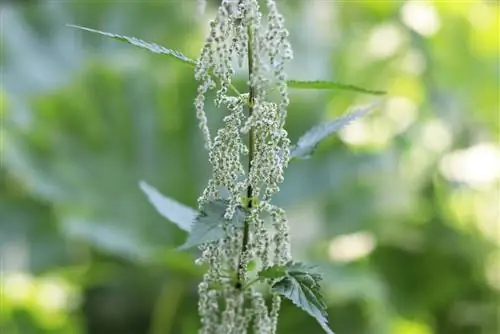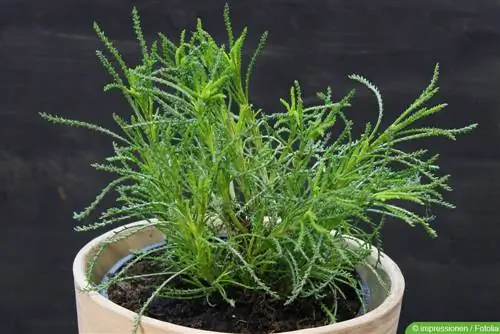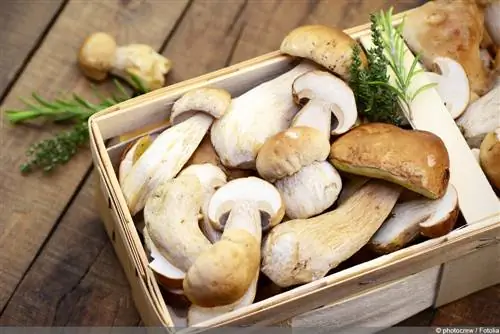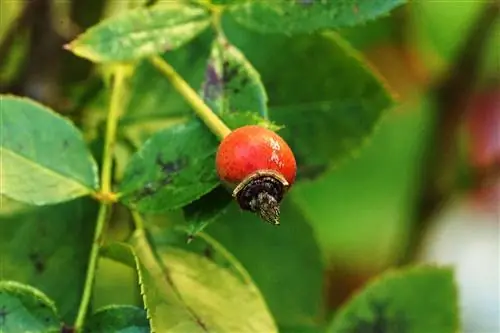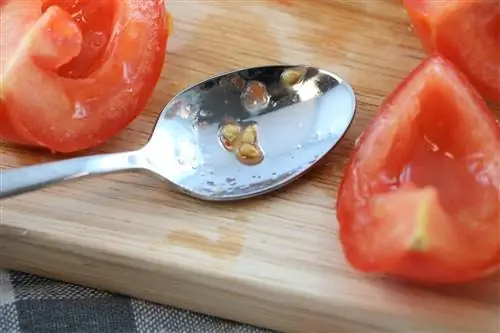- Author admin [email protected].
- Public 2023-12-17 03:39.
- Last modified 2025-01-24 12:45.
Nettle seeds are small miracles full of taste and healing power that nature provides in large quantities for free. They are so easy to harvest that even impatient people are quickly guaranteed a sense of success. They taste good and can be used in a variety of ways. To make the trip to collect nettle seeds even more worthwhile, there are also tips for processing the remaining nettle:
Collecting nettle seeds means: collecting defensive nature
There are probably people who are wondering why an article about the seeds of a useful wild herb has to discuss the harvesting of these seeds. It makes sense: While it is certainly true that everyone can find a few nettles, pluck them and harvest the seeds; It is not certain that every interested person would believe this.
“Anyone who collects their food from nature has to know their way around so as not to poison themselves” is the most common objection to “free food procurement”. Certainly correct, but who e.g. For example, if you don't want to feed your child a high percentage of sugar or eat antibiotics with their meat, you have to be familiar with it when shopping in a store and anyone who has looked at it in nature or in a few photos will recognize the nettle.
Or rather the nettles, because for nutritional and medicinal purposes you can collect large nettles (Urtica dioica), small nettles (Urtica urens) and, in the Havel catchment area, reed nettles (Urtica kioviensis). Otherwise we only have the pill nettle Urtica pilulifera, rare and only for use by herbalists; the remaining 41 species of the nettle genus are distributed throughout the rest of the world. Since the small nettle is not very common, has a small stature, burns badly and does not have a lot of seeds, and the reed nettle is only found in a select few, large nettles are usually collected (which is most worthwhile not only for the seeds).
The large nettle is native to all parts of the northern hemisphere where there are no tropical or arctic temperatures. It usually occurs in groups of several to many plants because it forms runners and often large clumps via its strong rhizome. As a nitrogen indicator, it can be found where the soil contains (too) much nitrogen, e.g. B. in over-fertilized gardens, extensive areas around manure-fertilized fields, weed fields in rubble areas and manure areas in villages.
Tip:
Beginners in the exciting field of “food gathering in the open field” don’t necessarily have to start with nettles (although it’s worth it, see ingredients below), but can stick to well-known fruits such as apples, pears and nuts. Because they can also be collected in the great outdoors, from avenue trees, former abandoned orchards, bushes on the edge of the forest, etc. Since collecting is fun for many people and it is absurd to let he althy fruit go to waste on the side of the road in order to buy expensive (and repeated) fruit When buying fruit that has been sprayed with pesticides in the store, a large community of people has formed who tell each other the best places to collect it. Resourceful people took up this current trend years ago and put Mundraub.org online, a website that identifies the freely accessible holdings with increasing effectiveness and has suggestions for an active thank you for almost every collection point (a little tree care, etc.).
Because stinging nettles can sting in a really unpleasant way. By the way, the TV chef got out at this point; he probably had unpleasant experiences with the wild herb as a child. Anyone who has ever been really “burned” can immediately relate to the fact that the silica-enhanced stinging hairs on leaves and stems “tick” are all the more unpleasant the more tender and sensitive the affected person’s skin is.
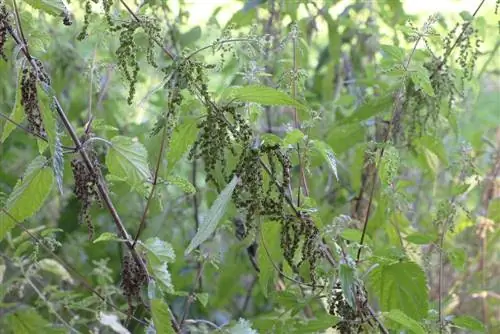
On planned collection trips, the stinging hairs are not really a problem: wearing long trousers and a long-sleeved T-shirt and “armed” with gloves, scissors and a large collection container, you will hardly come into contact with the stinging hairs. Apart from the harvesting tricks, the right time is also important when harvesting nettle seeds:
When do stinging nettles bear seeds?
Seeds are contained in infructescences of plants, fruits develop from flowers - seeds are available when the flowering period is over; ripe seeds a little later.
The large nettle blooms from July to October, and from August the first seed panicles hang on the plants. They ripen there until October and November, depending on the region, location and weather. A rich harvest can be obtained from the female nettles; the seed heads usually hang from them in richly filled splendor. The male nettles have similar panicles, only less densely packed and growing upright because of their low weight - because the panicles do not carry seeds, but rather threads with pollen capsules for pollinating the female nettles.
You can collect green=unripe or brown=ripe seeds, both are edible. The unripe seeds are better suited for fresh use, the almost dry brown seeds on brownish nettle plants are better suited for drying and storing. They have developed the wonderful, nutty taste and contain the full package of he althy ingredients.
Harvesting nettle seeds
This is how the nettle harvest produces the most seeds:
If possible, wait for a few sunny, dry days before you go collecting
The following equipment should be included:
Sturdy clothing and gloves described above, large scissors
And an easy-to-handle collection container:
- Large blue (Ikea) bag or large flat box lined with newspaper
- From midday until the afternoon, the seeds have accumulated most of the ingredients when exposed to sunlight
- Drying is also a lot quicker if water on the plant doesn't have to dry away first
- Green seed heads cling tightly to the stinging nettle stem, which is cut off and goes into the collection container
If the seeds are drier, the following preparation prevents losses during collection:
- Place the collection container under a swath of nettles
- Break off the stems at the bottom and drop or place them completely into the collection container
- The first brown seeds come off when the stem is broken, more on the way home
Drying nettle seeds
Professionals who press nettle seed oil from “the leftovers” of fiber nettles proceed as follows: The nettles are harvested at the optimal harvest time from late September to mid-October. The nettle twigs are bundled, hung upside down to dry and, once sufficiently dry, shaken out into a cloth. The occasional collector does not always have an eye on his nettles, so the harvest can result in different stages of ripeness of the fruit. A slightly different approach is recommended for each of these:
1. Green nettle seeds can theoretically be separated from the panicles; However, they are only suitable for immediate consumption anyway and should be eaten together with the young green nettle leaves by anyone who also needs time for other things.
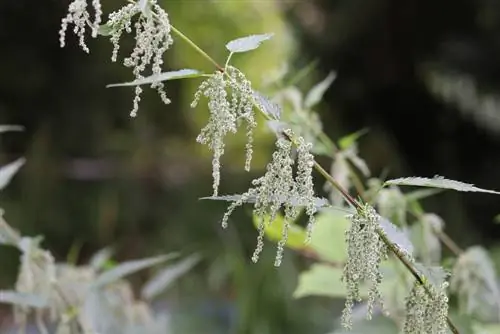
2. Well-ripe nettle seeds are dried, classically and preferably in the air: Place all the collected goods in the collection container in a dry, warm place so that air can reach the collected goods. But not full sun, that has a rather negative effect on the valuable ingredients of seeds, fruits and plant parts that have already been harvested, as it promotes degradation/oxidation. Let it stand for a few days and occasionally loosen it with your hand to loosen more seeds.
3. If you have harvested nettles with green leaves and half-ripe seed spikes, you can use the whole harvest. To do this, you need to strip the seed panicles from the stem, using gloves and from bottom to top. The leaves can now be separated and used for other purposes, the panicles are dried.
4. After a few days, separate the seeds from the panicles: Strip the stems over a bed sheet/newspaper and knead them, center the seeds on the base, place in a large, Pour a coarse sieve over a bowl of the same size and move until all the seeds from the remaining panicles have fallen through the sieve.
5. Nettle seeds are never all ripe at the same time. If you have already harvested well-ripe seeds, you can simply let the few green seeds slip through. They don't taste quite as nutty and spicy as the rest and take a little longer to dry out. Therefore, in this case, you might be better off putting the dry seeds in a tall glass with a piece left empty at the top. This fogs up if there is still too much moisture in the seeds, a simple and practical visual check, which may be a reason for further drying. If you harvested very early, you can separate the ripe seeds from the unripe seeds by placing all the seeds in water: ripe seeds collect at the bottom of the container, unripe seeds float at the top. Not so clever if the seeds have to be dried afterwards; necessary preparation if you e.g. B. want to press nettle seed oil.
6. The dried branches and the panicles, empty except for remnants, can be processed into nettle manure or disposed of (only in the compost if you want to harvest there soon).
7. The seeds are placed in airtight jars that are sealed and labeled. By the way, the ideal moisture level is 2-3%. To achieve this, professionals add desiccant to the storage containers. You can also do: Rice is a well-known desiccant, but needs to be replaced regularly because of its organic components.
Tip:
If you're in a hurry, you can dry the seeds in the oven: Lay them out on a tray with baking paper, put them in an oven heated to the lowest setting (35/40 degrees), and if the ovens close tightly, stick a wooden spoon in the door to keep the moisture out Remove and let it warm up for a while. Then loosen the seeds with your hands and taste them. If they turn brownish, feel quite dry and taste nutty, take them out and let them air dry for at least a day. Be careful with the temperature: Some ovens heat up so violently, even on the lowest setting, that they not only dry the seeds, but also roast them straight away. Can taste very good, but only if the seeds don't char.
The nettle: a powerhouse full of useful ingredients
Whatever and whenever you harvest from the nettle, you can use it, because it's not just the seeds that are valuable. Here is a short introduction to the “talents of the nettle”:
burning hair
Even the liquid in the stinging hairs is tough: each stinging hair is a single-celled tube that is hard and brittle like glass at the tip. The head has a predetermined breaking point and therefore breaks at the slightest touch. This is intended as a protective mechanism against predators; the slanted, sharp breaking point pierces the victim's skin just like the cannula of a syringe and releases its contents into the wound with some pressure.
This causes a brief burning pain and later itchy or burning welts on sensitive skin, but it's not really unhe althy. The good old priest Kneipp recommended “nettle whipping” to those suffering from rheumatism and gout, and even today some people with rheumatic complaints prefer to rub their aching limbs with fresh nettles every day rather than swallow medication with completely different side effects.
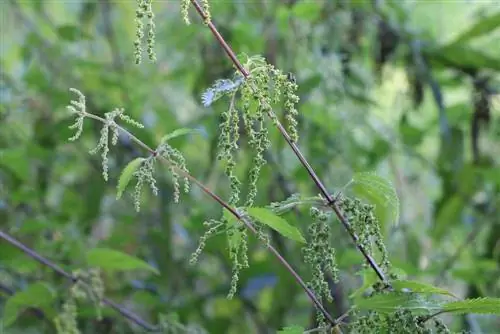
We now know why the burning substances actually have a healing effect: The histamine contained in the nettle venom causes the skin to redden, which is similar to an allergic reaction, but also expands the blood capillaries and ensures the release of the body's own tissue hormone histamine, which has a whole range of tasks in the body. For example, the acetylcholine, which is also contained in the burning cocktail, is better able to pass through the skin, and this neurotransmitter is responsible for the burning pain, but together with the serotonin, which is also contained in the burning cocktail, it also promotes blood circulation quite strongly, which relieves pain. Further positive effects are under discussion and are being investigated.
Nettle seeds
The nettle seeds contain approx. 25 - 33% oil (with 74 - 83% linoleic acid, almost 1% linolenic acid), vitamin E and carotenoids such as ß-carotene, lutein (recognized active ingredients for maintaining vision and preventing macular degeneration). Numerous other healing effects are also listed here, and the following also applies here: you don't have to take nettle seeds first if you have one of the diseases that the nettle seeds are supposed to work against. But you can eat he althily before you develop one of these diseases.
Nettle seeds are certainly a culinary asset, they taste a little nutty and a little spicy. Anyone who has actually learned to cook (and not just “replicate” recipes) knows exactly how to approach this new taste; People interested in eating with pleasure and on the way to cooking independently are usually recommended to try out nettle seeds in muesli and herb quark, salads and sauces. The seeds can be ground and roasted like other seed spices and then develop new flavor nuances.
Valuable nettle seed oil can also be pressed from the seeds, either with an oil mill or oil press or by maceration, e.g. B. with sesame oil. The high-quality, thick cooking oil is used dropwise wherever a good herbal oil fits.
Nettle leaves
The leaves of the large nettle contain quantities of vital substances, including minerals (magnesium, potassium, silicon, iron), vitamins (A and C), flavonoids (quercetin and kaempferol glycosides) and the anti-inflammatory agent coffeeoyl malic acid. The dry matter contains an impressive 30% protein, the root phytosterols, coumarin, lignans, lectins.
Nettle leaves have an anti-inflammatory and diuretic effect, e.g. B. for diseased urinary tracts, rheumatism and to prevent kidney stones. When consumed as a cure, they stimulate the entire metabolism and gently detoxify the body. Externally, nettle extracts are said to improve greasy and thin hair and promote hair growth, and several other positive effects of the nettle herb are propagated.
They can be drunk as tea, consumed as soup, spinach, herb butter, pesto or smoothie and can be processed for numerous cosmetic and horticultural applications. The shoots/shoot tips offer the best taste in spring. Wring them in a cloth, cut them very finely, roll them through with a rolling pin, shower them vigorously, blanch or boil them to prevent the nettle hairs from pricking. Older nettle leaves, collected from early summer onwards, are better used for external applications because cystoliths (calcium carbonate deposits) accumulate in them, which can irritate the kidneys if consumed.

